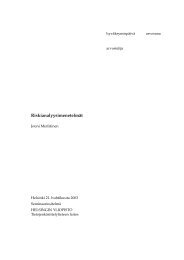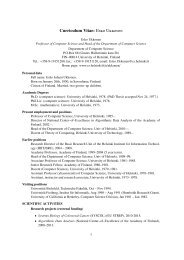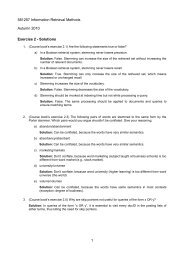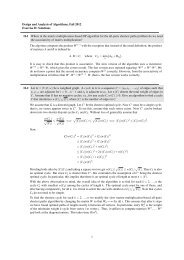Calculating trust in sensor networks
Calculating trust in sensor networks
Calculating trust in sensor networks
Create successful ePaper yourself
Turn your PDF publications into a flip-book with our unique Google optimized e-Paper software.
node si about node sj while monitor<strong>in</strong>g the function f. σk is the success of observation<br />
k, a negative observation would have a value −1 and a positive observation would have a<br />
value of 1 with a scale of anyth<strong>in</strong>g <strong>in</strong> between for partially successful actions. ρ(t, tk) is a<br />
time dependent function that gives higher relevance to past values of σk.<br />
Indirect <strong>trust</strong> <strong>in</strong> CORE works by neighbours shar<strong>in</strong>g only their positive observations about<br />
other nodes. This approach is chosen as a means to combat denial of service-attacks from<br />
malicious nodes that could otherwise badmouth good nodes.<br />
Functional reputation <strong>in</strong> CORE means a comb<strong>in</strong>ed metric of both direct- and <strong>in</strong>direct<br />
reputations accord<strong>in</strong>g to function f. All of the functional reputations of a node can then<br />
be comb<strong>in</strong>ed <strong>in</strong>to one global reputation-value that different weights to different functional<br />
reputations. Each node must ma<strong>in</strong>ta<strong>in</strong> a Reputation table where it stores the direct- and<br />
<strong>in</strong>direct reputations of each observable function for every neighbour<strong>in</strong>g node.<br />
The f<strong>in</strong>al <strong>trust</strong>-value is def<strong>in</strong>ed as such:<br />
reputation t si = � wk ∗ (directreputation t si (sj | fk) + <strong>in</strong>directreputation t si (sj | fk)<br />
Where wk is the weight associated to the functional reputation of function fk.<br />
The article does not specifically def<strong>in</strong>e which sort of behaviour (or functions) nodes should<br />
monitor about their neighbours. It does suggest however, that packet forward<strong>in</strong>g and<br />
rout<strong>in</strong>g functions should be monitored to ensure efficient operation of the network, with<br />
more weight given to packet forward<strong>in</strong>g.<br />
Instead of a proprietary monitor<strong>in</strong>g scheme, each node <strong>in</strong> CORE uses the Watchdog-<br />
mechanism [MGLB00] to validate other nodes behaviour. Watchdog is summoned every<br />
time the correct execution of a function by another node must be verified. It does this by<br />
stor<strong>in</strong>g all expected behaviour to a buffer. It then compares the observered behaviour to<br />
this buffer and removes the entry <strong>in</strong> case the expected and observed behaviours match.<br />
This is also marked as positive behaviour and the reputation table is updated accord<strong>in</strong>gly.<br />
If an entry stays <strong>in</strong> the buffer for too long, it is marked as a negative observation and also<br />
marked <strong>in</strong> the reputation table.<br />
An entry is stored <strong>in</strong> the reputation table for each observed function of other nodes. A<br />
22
















